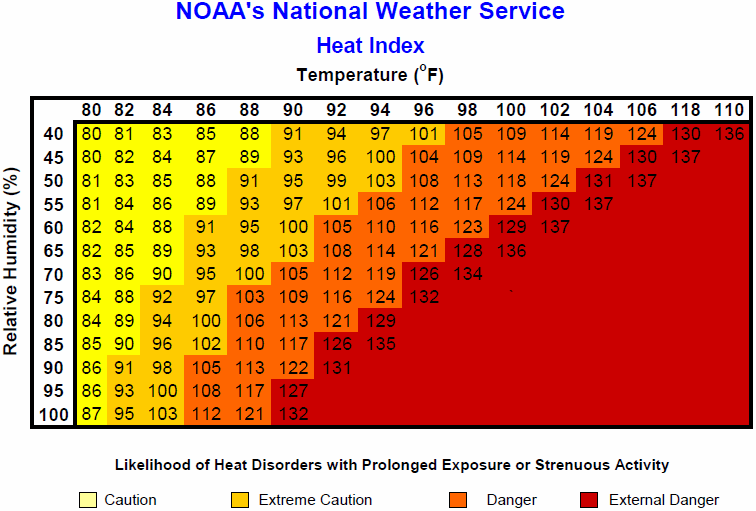Will Hatheway, Class of 2012, is a local meteorologist living in central Texas.
During the summer, whether it is from the local meteorologist on TV or your weather app, you will likely see the Heat Index for the day. While the Heat Index can give you an idea of how dangerous the heat can be, the Wet Bulb Globe Temperature provides a better view of how hazardous the temperature is. But before I go too in-depth, I want to give a brief history of the Heat Index for comparison.
The Heat index is a measure of how “hot it feels” to the human body. The Heat Index indicator is determined by inputting relative humidity and the temperature, taken in the shade, into the chart listed below.
Image courtesy of the National Weather Service, NOAA
You’ll notice I mentioned meteorologists take the temperature in the shade. This reality might come as a surprise since most outdoor activities are under direct sunlight and not a covered, shaded facility. Because of this, the actual Heat Index could be much higher, up to 15°F, depending on if you are in direct sunlight.
Now humidity is a vital part of the Heat Index equation. Even a little variation in atmospheric moisture at high temperatures can result in a significant change in Heat Index calculations. Humidity is essential to the human body because it impacts the evaporation of sweat. If the air moisture is high, sweat on the surface of the skin cannot evaporate and cool the body quickly. Conversely, if the humidity is too low, sweat evaporates too fast and can lead to dehydration.
The Heat Index is widely used by school districts, athletic programs, youth programs and marching bands to determine if it is too dangerous for their participants to be outside. Depending on how hot the Heat Index says it will be will impact whether or not organizations implement a program’s severe heat plan. For example, below is a statement from College Station Independent School District:
Image Courtesy of the College Station Independent School District Athletic Department
As stated earlier, meteorologists calculate the temperature in the shade. It doesn’t take into consideration other variables such as Actual Temperature, Wind Speed, Sun Angle, Cloud Cover, or Physical Activity. These are essential factors to consider when being outside.
Sadly, there have been several cases where students have been severely injured or even died, due to severe heat. In Wetumpka, Alabama, 25 students were overheated and seven were taken to the hospital due to heat exhaustion while playing outside at recess. According to the local meteorologists, the Heat Index was only in the upper 90s with temperatures in the low 90s.
Looking at the statement from CCISD, under a similar situation, the Hot Weather Guidelines wouldn’t have gone into effect. So what should we do as a community to better protect our children and participants outside? Perhaps we need to change what parameters we look at for heat-related stress?
Luckily, there is a little known parameter known as the Wet Bulb Globe Temperature (WBGT). The WBGT is similar to the Heat Index in that it is an indicator of the stress on the body from the heat. However, unlike the Heat Index, the WBGT looks at several factors: Air Temperature, Humidity, Wind Speed, Sun Angle, Cloud Cover and Physical Activity.
So where did the WBGT come from? Is it a relatively new weather parameter just recently developed in response to all the heat-related injuries and deaths? Sadly no, the WBGT was developed in the 1950s after heat-related illnesses affected the U.S. Army and Marine Corps. After the implementation of the WBGT, the heat-related illness and injuries in the military dramatically decreased. The WBGT is still used today in the military to measure severe heat risk.
Below you will see the WBGT chart used by the U.S. Military:
Image Courtesy of the U.S. Army
You might be asking yourself “Why hasn’t my school district adopted these parameters to protect our children and outdoor activity participants better?” The University Interscholastic League (UIL), the governing body in Texas that makes the rules for school athletics, bands and extracurricular activities, has adopted the WBGT. On the UIL’s website, you can see all their recommendations for dealing with heat-related stress. On the website, recommendation number six states, “Know both the temperature and humidity. The greater the humidity, the more difficult it is for the body to cool itself. Test the air prior to practice or game using a wet bulb, globe, temperature index (WBGT Index) which is based on the combined effects of air temperature, relative humidity, radiant heat and air movement. The following precautions are recommended when using the WBGT Index (ACSM’s Guidelines for the Team Physician, 1991).”
This statement seems to indicate that the UIL is well aware of the benefits of using the WBGT instead of the Heat Index.
Now I am not saying that your school districts and the one listed in this article are intentionally ignoring the UIL recommendations. They may just not have heard of the WBGT, or don’t understand the difference between the Heat Index and the WBGT.
I ask that everyone who reads this article help spread the word about the WBGT. Check with your local schools, extracurricular organizations, and local governments about adopting the WBGT over the Heat Index. It is only through grassroots support that we as a community will be able to make the change and better protect the public.
How to protect your children from heat related injuries and death
February 10, 2020
Photo by Creative Commons
Guest Opinion Contributor Will Hathaway, meteorologist and former Texas A&M student, discusses what the heat index means and how you can use that information.
0
Donate to The Battalion
Your donation will support the student journalists of Texas A&M University - College Station. Your contribution will allow us to purchase equipment and cover our annual website hosting costs.
More to Discover















